Friends with Fiber Winter 2024 Journal, Out Now!
January 3, 2025
Surface Design Association is excited to announce Friends with Fiber, our Winter 2024 edition of Surface Design Journal. “Artists are natural explorers⎯drawn to experimentation in concept, material and technique. Friends with Fiber celebrates those individuals who push the boundaries by combining disparate materials and techniques in exciting new ways. For example, clay and fiber appear to be great friends. Perhaps it’s the tactile qualities, or the malleability of each medium? Dare I say they go together like peanut butter and jelly? This issue also includes artists who have stepped outside their comfort zone to embrace the media and techniques of fiber art. Friends with Fiber is really about recognizing the power of fiber when activated by artists’ hands.” –Elizabeth Kozlowski, Surface Design Journal Editor
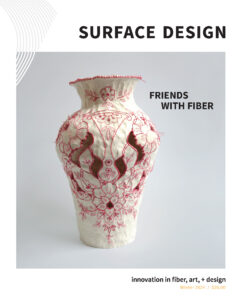
Here’s a preview of what you’ll discover:
The Quilts Of Hank Willis Thomas by Paulette Young, Ph.D: “Thomas created quilts from the deconstructed uniforms, torn into fragments and restructured into labyrinths. Within the maze is a word that represents American ideals.”
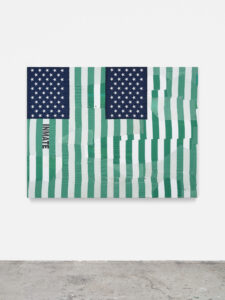
Hank Willis Thomas, After Flags I (green), 2022. Mixed media with U.S. Flags and decommissioned prison uniforms, 60 x 72 inches. Images courtesy of the artist.
Bringing It Home: Caroline Harrius Examines The Historic Places Of Women’s Work by matt lambert: “Harrius dug not only in the tombs of historical archives but also in her own family home. Unpacking collections of her grandmothers, in a home passed down through generations and where her parents still reside, she found a house filled with domestic handcraft.”
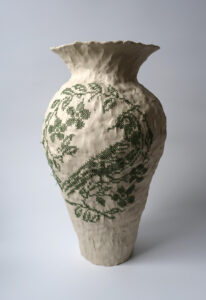
Caroline Harrius, Object with Bird, 2021. Coiled porcelain
stitched with cotton thread, 18.5 inches tall. Photo by the artist.
Exploring Material Convergence Through Textiles And Metals by Seongeun Lee and Bogyeom Kim: “The TP Project explores academic convergence from a formative perspective, firstly in experimentation with form and structure. Textile artists create various forms based primarily on the physical properties of materials. In other words, they utilize the flexibility, flow, texture, and density of fabrics to create unique shapes and structures. Industrial designers artistically draw out the structure and materials designed for a clear purpose of a product.”
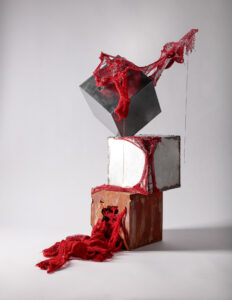
Seongeun Lee and Bogyeom Kim, DE 01, 2024. Metal with
wool and silk yarn, 31.5 x 8 x 10 inches. Photo by the artists.
Feeling The Body Of Wool: Movement-Based Forums For Felting And Community Care by Taylor Hanigosky: “Through tactile methodology, intuitive practice and contextual research, we can work within the process of felt making to re-inhabit the body as shapeshifter. We can learn feral survival strategies from bands of sheep who escape the containment of domestication to re-integrate wild behavior patterns.”
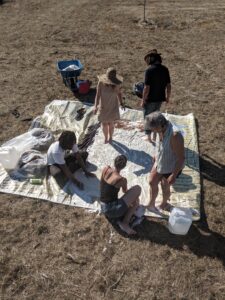
Wet felting, San Juan/Discovery crossing, 2018. Photo by
the artist.
Exposure: A Gallery Of SDA Members’ Work: “This Journal featured seven members’ work who blend fibers and other materials together in interesting ways. From puzzle pieces and sad irons, to sound and ceramic, I’m always impressed by the work our members create. We had a record number of submissions this time around, and it was really hard to pick the final seven!”
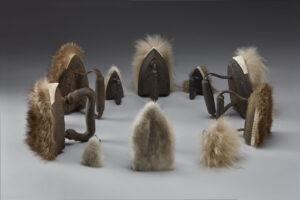
Carole Kunstadt, PRESSING ON: Homage to Hannah More, 2023. Assemblage with antique sad irons, repurposed fur, scorched pages by Hannah More dated 1791, 22 x 22 x 8 inches. Photo: Robert Hansen-Sturm.
In The Studio: Weaving Clay and Thread: Reinterpreting Iranian Tapestry Patterns Through Ceramics by Maedeh Tafvizi: “This project is an exploration of how identity, space and material intersect to shape emotional and physical experiences. Drawing on the rich tradition of Iranian tapestry, I sought to reinterpret intricate Zillo patterns historically used in mosque flooring through the lens of ceramics.”
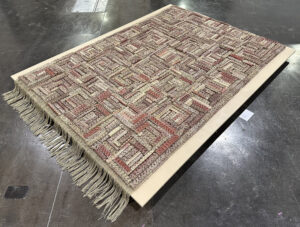
Maedeh Tafvizi, Grief Resonance, 2024. 3D-printed ceramic and yarn installation, Convention Center, Providence, RI, 6 x 8 feet. Photo by the artist.
In The Studio: Hard and Soft/Neon and Fiber by Linda Marcus: “Fiber and neon are two seemingly opposite materials. Fiber is tactile, soft and easily manipulated; neon is hard, made of glass and full of gas. Fiber is most often associated with quilts and wall hangings. Neon is a colorless gas often encased in a tube which emits a red-orange glow when electrified. It was discovered in the early 1900s and made popular with advertisements in Los Angeles. For me, growing up in Southern California, neon was as common as oranges and palm trees.”
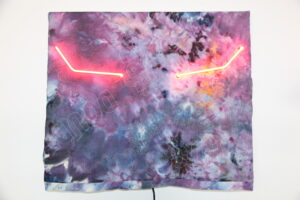
Linda Marcus, Shoot from the hip, 2022. Hand-dyed and embroidered bed sheets with neon, 34 x 22 inches. Photo: John Grant Photography.
First Person: Cyborgs, Fathers and Other Familiars by Matt Johnson: “The cyborgs’ metamorphosis is in aid of adaptation and survival. They are resilient stoics, scavenging a world depleted of resources, much as I procure their components from thrift shops, roadsides, flotsam and my own garbage. Derived from warrior archetypes, they typically incorporate elements of uniforms and armor or draw inspiration therefrom.”
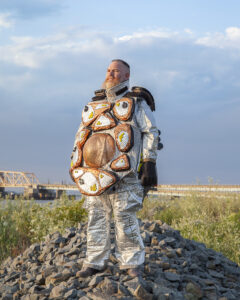
Matt Johnson, Full Metal Bandersnatch (Cyborg #4) (front view), 2023. Machine- and hand-sewn firefighting turnout gear, EVA foam, sauna suit, air
conditioner covers, lamé, chino, PVC pipe, cord keepers, construction knee pads, TheraBands, garden lights, LED strips, wine bottle bag, grip tape,
insulated grocery bag liner, toy carrying case and Velcro, 60 x 36 x 20 inches. Left page, top: rear view. Photos: Joey Moon.
First Person: The Threads that Connect Us by Nosheen Iqbal: “I found myself experimenting with various mediums and materials, revisiting techniques I had developed a fondness for during school and through my professional career. Textile work and surface design, however, captivated me the most. I drew inspiration from traditional Pakistani textile treatments like Ajrak printing, Pulkari and Baagh stitching, but also from the intricate architecture of Punjab.”
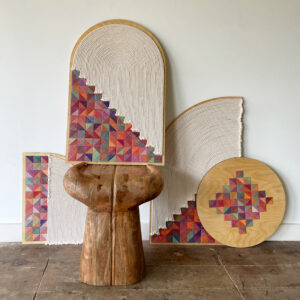
Nosheen Iqbal, Virgin Voyagers, 2022. Hand-embroidered Baltic birch and cotton fiber, 18 inches x 12 feet. Photo by the artist.
First Person: Loom to Shutter: Dancing Between Mediums by Naomi L. Ben-Shahar: “I combined the weaves and paintings with my analog photographs of desert dunes that resembled the curvature of women’s bodies to make a series I titled ‘Cosmology Collages.’ It corresponded to my exploratory state of mind at the time.”
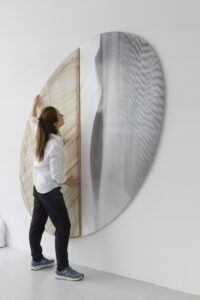
Naomi L. Ben-Shaharr with Primal Radiant Force, 2024. Photo: Alan Wiener.
Made Aware: From Insulation to Art: Building with Hemplime by Anna Valenti: “In my studio practice, I explore the potential of hemplime, a material that aligns with my passion for sustainability and environmental consciousness. Hemplime, a blend of hemp fibers and lime, offers a range of unique properties that make it a wonderful choice for an environmentally friendly building material.”
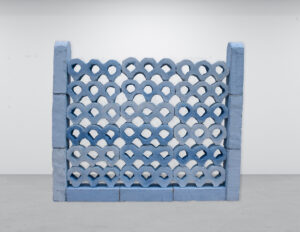
Anna Valenti, Garden Wall, 2024. Hemplime block, press molded and cut to form with hemp shiv, hydraulic lime, copper oxide and clay pigment, finished with hemplime plaster, 84 x 12 x 72 inches. Photos by the artist.
In Review: Walter Oltmann: Metamorphosis reviewed by Jessica Hemmings: “Hybrids of insects and extraterrestrials appear in the ten woven wire sculptures that comprise Walter Oltmann’s Metamorphosis exhibition… Johannesburg-based Oltmann acknowledges one reference point are the wire craft traditions of southern Africa that conjure creatures from bent lines, but equally at play is what he sees as the material culture of his own German family heritage of lacemaking, knotting and coiling, as well as gabion structures, metal mesh filled with rocks that are used as retaining walls to combat erosion.”
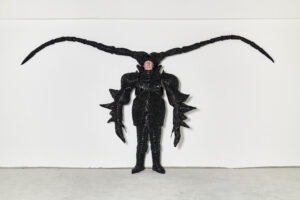
Walter Oltmann, Carapax (Borer), 2023. Anodized aluminum wire and spray paint, 80.75 x 157.5 x 19.5 inches. Photo: Anthea Pokroy. Courtesy of the artist and Goodman Gallery.
In Review: Beyond the Surface: Contemporary Artists and Printed Textiles reviewed by Rachel Harris-Huffman: “Beyond the Surface: Contemporary Artists and Printed Textiles at the Schweinfurth Art Center in Auburn, NY, brings together eight American artists whose works integrate printmaking and textile art practices, techniques that straddle the boundaries of fine art and craft, aesthetic design and utility. While the exhibiting artists possess disparate perspectives and conceptual mainsprings, commonalities emerge among methodologies, materials and social commentaries.”
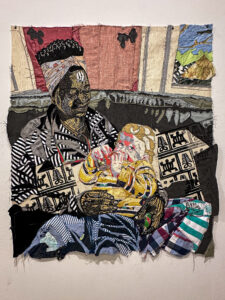
Krystle Lemonias, My Man Can Eet Eeh; Go Put Dis in the Gahbage,
2021. Woodblock print, baby clothes and Larabar packaging on upholstery fabric, 46 x 41 inches. Photo by the author.
In Print: The Textile Reader, Second Edition reviewed by Elizbeth Kozlowski: “No one publication can encompass a whole field and no one person is an expert in entirety. By choosing to highlight the eclectic rather than the authoritative and be inclusive of the greatest number of voices possible in The Textile Reader, Hemmings attempts to avoid the establishment of a canon, one whose past is so fraught with hegemony, focusing instead on how and with what to expand the reader’s curiosity.”
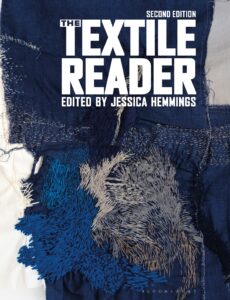
The Textile Reader, Second Edition: Florencia Walfisch, Lenguaje
(Language) (detail), 2020. Embroidered and pieced textile. Photo: Daniel Duhau. Image courtesy of the artist and Galería Van Riel.
Spotlight on Education: Craft in America: SCIENCE and COLLECTORS by Erin Cooney: “‘Every quilt has a story,’ says Dr. Carolyn Mazloomi. Mazloomi is one of three quilt artists featured in the latest season of Craft in America, the award-winning documentary series airing on PBS. Two new episodes, ‘SCIENCE’ and ‘COLLECTORS,’ will air on PBS on December 27, 2024, and stream digitally starting November 12, 2024.”
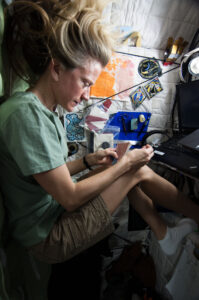
Dr. Karen Nyberg sewing on the International Space Station, 2024. Photo courtesy of NASA.
Emerging Voices: Exploring the Invisible: Capturing the Energy of Auras through Bioplastics by Andrea Loyer: “The exploration of material is a key part of any creative process, but for me, it’s also a way to investigate something deeper: the unseen energy that flows within and around us. Over the course of ten months, I embarked on an artistic journey to capture the dynamic, ever-shifting qualities of auras. These invisible energy fields became the core of my project.”
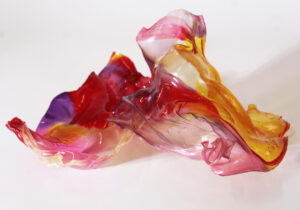
Andrea Loyer, Color, Light and Movement, 2024. Gelatine, glycerin, water, ink and bioplastic, 7 x 5 inches. Photo by the artist.
To buy a copy of Friends with Fiber, go to the SDA Marketplace, or you can check out a free digital sample on our SDA Journal page.
